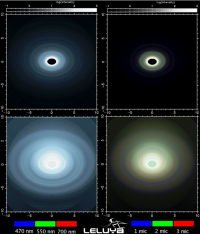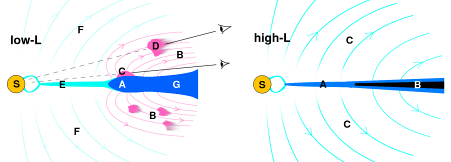SEE ALSO "Protoplanetary Disks"
SEE ALSO "Modeling dust dynamics "

Animation of the imaging at different wavelengths (MPEG format, click on the image, 1.8Mb)
See also the figure below.
Planet formation is believed to occur in dense disks of
gas and dust surrounding young pre-main-sequence (PMS) stars, but
the current understanding of this process is very limited.
My work on young PMS stars initially started with
addressing the problem of some observations showing large scale
halos around protoplanetary disks. This halo had been traditionally
ignored in the analysis of observed spectra and images, which often
resulted in seemingly conflicting results. My collaborators and I
were the first to recognize that this halo can be the dominant
component in observations. This was demonstrated for several
observed massive pre-main-sequence stars (Miroshnichenko et al.
1999, ApJL, 520, L115) where this resolves all the conflicts in a
most natural way. Such a halo has far-reaching consequences for the
disk structure and evolution because it provides additional disk
heating and consequently influences the disk stability and dust
grain growth.

Theoretical disk-in-halo model images at 30 microns and various
inclination angles. In general, the observed images depend on the
observational wavelength, telescope resolution, camera sensitivity
and intrinsic ratio between the disk and halo surface brightness.
We also showed that the measured flux can not
discriminate between the surface of a flared disk and an optically
thin halo; only imaging at various wavelengths can do that
(Vinkovic et al. 2003, MNRAS, 346, 1151). Since
comparisons between theoretical and observational imaging are rarely
performed for individual objects, it is not clear how much of the
current understanding of the protoplanetary disk evolution is
undermined by this degeneracy.

Theoretical model images of the close environment of a young
star. Upper row: disk without halo; Lower row: disk + halo
Especially interesting, and still poorly understood, is the
environment within several astronomical units (AU = distance between
the Earth and the Sun) of these stars. This region comprises the
inner protoplanetary disk where dust evolves from submicron
particles to terrestrial planets, bipolar jets are launched, disks
accrete onto the star and disk winds form. Understanding the
protoplanetary disk structure is prerequisite for investigating
these phenomena.
Comparisons of inner
disk models with observations suggest that disk alone
may not always explain the data unless an additional dusty component
in a form of dusty wind is added to the models (Vinkovic et
al. 2006, ApJ, 636, 348; Vinkovic & Jurkic 2007, ApJ, 658, 462).
This wind surrounds the disk and creates
a tenuous dusty halo around the inner disk regions. The exact
process of supplying the wind with dust is not known, but
observations can shed a light on this if we can reconstruct the halo
properties.
In recent years, the near-infrared interferometry has emerged as a
powerful observational method for exploring the inner disk regions.
One of the major results is that the configuration of inner disk region differs
dramatically between young PMS stars of luminosity smaller than about
1000 solar luminosities (low-L objects) and those with luminosity
larger than 1000 solar (high-L). The structural differences in
circumstellar environment between these two groups are sketched in the
figure below.
Vinkovic, D., & Jurkic, T. 2007, ApJ, 658, 462 (PDF)
Vinkovic, D., Ivezic, Z., Jurkic, T., & Elitzur, M. 2006, ApJ, 636, 348 (ADS, PDF)
Vinkovic, D., Ivezic, Z., Miroshnichenko, A.S., & Elitzur, M. 2003, MNRAS, 346, 1151 (ADS, PDF)
Miroshnichenko, A., Ivezic, Z., Vinkovic, D., & Elitzur, M. 1999, ApJL, 520, L115 (ADS, PDF)

The emerging picture of the inner protoplanetary disk structure
based on observed properties of high-L and low-L young PMS stars
(Vinkovic & Jurkic 2007, ApJ, accepted).
Left:
Low-L objects (luminosity smaller than 1000 solar luminosities)
have two competing models explaining their near-infrared (NIR)
visibilities and anomalously high NIR excess: (A) puffed-up inner
disk rim and (B) dusty outflow creating a halo around the inner
disk. Detected variability due to dust obscuration events suggests
that either (C) the height of puffed-up rim is variable and
temporarily blocks the view toward the star or (D) clumps of dust
appear in the dusty outflow and occasionally intercept the line of
sight. The disk inside the zone of dust sublimation (E) is optically
thin, while the rest is optically thick (G) due to dust. Gaseous
stellar and disk wind (F) are also present.
Right: High-L (luminosity larger than 1000 solar luminosities)
YSOs have a simpler structure. The star is surrounded by optically
thick gaseous accretion disk (A), which extends much closer to the
star than the dust sublimation distance. But dust still may survive
within the optically thick disk interior (B). Intense gaseous
stellar and disk wind (C), combined with the stellar radiation
pressure, are efficiently dispersing the surrounding environment.
(S) marks the star.
|